HashWhale BTC Mining Weekly Report | BTC price hits a new high, miners' income gradually recovers (4.26-5.02)
1. Bitcoin Market
From April 26 to May 2, 2025, the specific trend of Bitcoin is as follows:
April 26 : On the previous trading day, the price rose from $93,500 to $95,586, and then fluctuated at a high level around $95,000. The intraday volatility gradually narrowed, showing signs of weakening momentum. The market then pulled back, with prices falling to $94,583, $94,339, and $94,001, and finally stabilizing around $94,320.
April 27 : The price briefly rose to an intraday high of $95,172 before encountering resistance and failing to stabilize, and then fluctuated back to $93,815. After that, the bulls and bears entered a tug-of-war, and the market showed a narrow range of fluctuations. The price fluctuated between $94,261, $93,762, $94,140 and $93,823, lacking clear direction guidance.
April 28 : Bulls exerted their strength in the short term, pushing the price up to $94,395 and maintaining it at that level for a while. However, the market then saw significant selling pressure, breaking the key support level of $93,500 and hitting a low of $92,933. A rapid rebound followed, with the price rising to $94,872 and the intraday high of $95,512. In the late trading session, bullish momentum weakened, and the price fell back from the high to the $94,500 area and then further fell to $93,603.
April 29 : Bitcoin price rebounded after fluctuating around $93,621, rising to $94,892, and then rebounded to $95,328 after a brief correction. The overall intraday trend was volatile upward, and the price rebounded again after a correction to $94,258, and then rose to $95,068, $95,235, and $95,466, respectively, and fluctuated around $95,000.
April 30 : On that day, the price of Bitcoin started to pull back from the intraday high of $95,444, fluctuated down to $93,937, stabilized and rebounded, and then gradually climbed to $95,078. After a brief correction to $94,622, the price rose again, reaching $95,158. However, the market suddenly changed and fell rapidly. The price fell sharply to $93,376 in a short period of time, forming a cliff-like decline. After that, market sentiment gradually recovered, and the price returned to the upward channel, rebounding to around $94,000, and entered a sideways consolidation phase within this range.
May 1 : Bitcoin briefly dropped to $93,803 in the early trading of the day, and quickly stabilized and started a rebound after hitting the intraday low. The price fluctuated upward, breaking through three key short-term resistance levels of $95,000, $96,000 and $97,000, respectively, and rose to $94,943 and $96,315, reflecting the gradual warming of bullish sentiment. Finally, driven by bullish momentum, the intraday high was recorded at $97,436, setting a new high this week, showing that the market buying power has increased.
May 2 : After Bitcoin maintained a consolidation above $97,000 for a period of time, it encountered selling pressure from above and the price began to fall. During this period, the game between long and short was fierce, and the price briefly pulled back to around $96,245 to gain support, and then rebounded to $97,149, but failed to continue the breakthrough momentum and then fell again under pressure. As of writing, Bitcoin is at $96,825, and is generally in a high-level consolidation stage. In the short term, we still need to pay attention to the gains and losses of the $97,000 line and the sustainability of bullish momentum.
Summarize
This week, Bitcoin maintained an upward trend as a whole, showing a strong oscillation pattern. During this period, it repeatedly hit the key resistance areas of US$95,500 and US$97,000, and successfully broke through, reaching a maximum of US$97,436, setting a new interim high. The overall trend showed a wide range of oscillations, the market volatility increased significantly, and the capital sentiment tended to be active.
The lowest price during the week fell back to $92,933, testing the validity of the support range below. The price then rebounded quickly, confirming that $93,500 and $94,000 formed a short-term stable support zone, becoming the core area of long-term defense. On May 1, Bitcoin broke through the $97,000 mark, reaching the high point of this round of rebound, but there is still strong pressure above $97,500, which constitutes the main resistance level in the short term.
In terms of market sentiment, risk appetite has rebounded significantly, overall liquidity has improved, fund activity has increased, and trading volume has moderately increased, indicating that off-market funds are more willing to enter the market. If the subsequent macro environment remains stable and the price can effectively stabilize above $97,000, Bitcoin is expected to open up further upside space and hit $98,500 and the integer mark of $100,000.

Bitcoin price trend (2025/04/26-2025/05/02)
2. Market dynamics and macro background
Fund Flows
1. BTC supply on centralized exchanges hits 7-year low
As of April 26, the total supply of Bitcoin in CEX fell to 2.488 million BTC, the lowest level since October 2018. Despite a brief rebound of 40,000 BTC over the weekend (rising to 2.492 million BTC), it is still at a historical low overall, indicating that market participants are transferring BTC to cold wallets or holding them for the long term, and funds are showing a long-term bullish signal.
2. The proportion of whales has decreased, and retail investors have increased their activities
According to CryptoQuant data, the exchange whale ratio has dropped from 0.512 on April 17 to 0.36 on April 27, indicating that the proportion of large transfers (>100 BTC) in exchange transfers has decreased significantly.
At the same time, on-chain data shows that the number of active UTXOs and the activity of small addresses (<1 BTC) have increased, indicating that retail investors are trading more frequently and are gradually dominating short-term market fluctuations.
3. Bitcoin ETF recorded the largest weekly net inflow, and institutions drove the rebound
On April 26, as the price of Bitcoin rebounded to $95,800, the U.S. spot Bitcoin ETF ushered in the largest single-week net inflow since Trump's inauguration. According to data from Santiment and Trader T, net inflows totaled $3.033 billion last week, with a trading volume of $19 billion. The rapid inflow of funds may be related to the recovery of basis trading, which pushed the total net inflow in April to about $2.26 billion, reversing the previous outflow trend.
This week’s ETF inflow breakdown:
April 28: +$591 million
April 29: +$172 million
April 30: -$56.3 million (small outflow)
May 1: +$71 million
Overall, despite a small net outflow on April 30, the overall capital trend still points to a net inflow, reflecting the market's relatively optimistic outlook on Bitcoin's medium-term trend. If this trend continues, it may continue to provide downward support and medium-term upward momentum for Bitcoin prices.
Technical indicator analysis
1. Relative Strength Index (RSI 14)
According to Investing.com, as of May 2, 2025, Bitcoin's 14-day relative strength index (RSI) is 63.36. This value is in the bullish area (50-70) and has not yet entered the overbought area (>70), but it has shown that the market bullish momentum is dominant.
The current RSI is in the middle to high range, indicating that buying momentum is still dominant, but it also suggests that there are some signs of price weakness. If the RSI continues to approach 70 or even break through, we need to pay attention to the possible short-term correction risk.
2. Moving Average (MA): The trend structure is clear and the bullish pattern is not broken
50-day moving average (MA 50): $86,467.47
200-day moving average (MA 200): $81,766.41
Current price (market price): about $96,800 (above both moving averages)
Technical structure: Golden cross pattern
Currently, MA 50 has steadily crossed MA 200, forming a typical "Golden Cross" pattern, which is usually regarded as a confirmation of a medium- to long-term bull market signal. This structure strengthens the market's expectations for continued upward movement.
The current price is significantly higher than MA 50 and MA 200, confirming the continuity of the medium- and long-term upward trend. The MA arrangement shows a typical bullish structure (short-term > medium-term > long-term), indicating that the market has not yet experienced structural damage. However, as the price deviates significantly from the moving average in the short term, there is a certain mean reversion pressure, and the market may face a technical correction or shock consolidation in the future.

50-day SMA, 200-day SMA data chart
3. Key support and resistance levels
Support level : The current main support range of Bitcoin is between $93,500 and $94,000, which is an important short-term correction line. If the price falls back to this area, it is expected to attract some long buying orders and may form a technical rebound.
Resistance : The initial resistance above is concentrated around $97,000 and $97,500. If the price can effectively break through and stabilize above $97,500, it is expected to open up further upside space and test the psychological round mark of $100,000.
Market sentiment analysis
1. Market optimism has recovered and capital liquidity has increased
Market optimism rebounded significantly this week, with multiple on-chain and sentiment indicators improving simultaneously, reflecting the gradual recovery of investor confidence:
The Bitcoin Bull-Bear Market Cycle Indicator rose to 60 on April 28, a three-week high; the data comes from CryptoQuant analyst Julio Moreno, who pointed out that the liquidity of stablecoins and Bitcoin on exchanges has risen at the same time, indicating that funds are flowing back into risky assets.
2. Key Sentiment Indicators (Fear and Greed Index)
According to CoinMarketCap data, as of May 2, the Fear & Greed Index was 55, which is in the "neutral" zone. This week, the index showed a flat trend: April 26: 53 (neutral); April 27: 53 (neutral); April 28: 51 (neutral); April 29: 53 (neutral); April 30: 52 (neutral); May 1: 51 (neutral).
The index fluctuates between 51 and 55, reflecting that market sentiment is stable and investors are neither overly panicked nor irrationally greedy; the index fluctuates slightly, indicating that investors are taking a wait-and-see attitude amid recent price fluctuations, with confidence gradually recovering but not obviously aggressive; sentiment has not entered the stage of greed, indicating that the market still has room for upside and has not yet overheated.
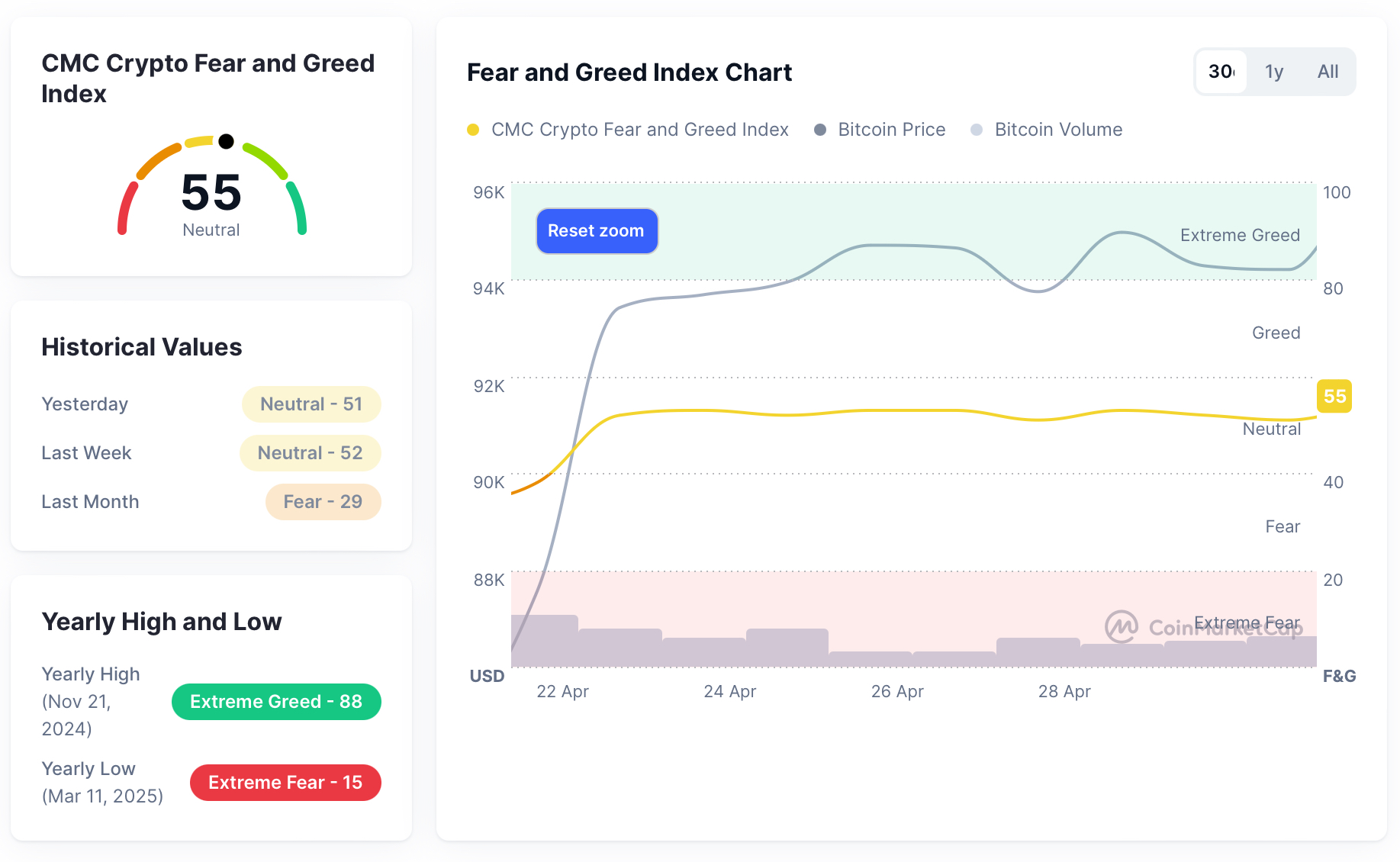
Fear and Greed Index Data Picture
Macroeconomic Background
1. The re-emergence of trade tensions between the US and Europe may lead to major adjustments in global tax policies
The European Union is considering amending its 15% minimum corporate tax law to ease tensions with a potential new U.S. administration. The law, which takes effect in 2023, is intended to align with the global unified tax system under the G20 framework, but the U.S. is concerned that its companies will be constrained by EU rules. If implemented, this move could herald a regression in future cross-border tax policy coordination, further affecting cross-border capital flows and corporate risk aversion.
2. Trump’s policy expectations will reshape the geopolitical and trade landscape
Trump has recently spoken intensively, reiterating that he will not easily cancel tariffs on China and emphasizing that China needs to make "substantial concessions". At the same time, he has actively participated in the mediation of the situation between Russia and Ukraine and promoted the Ukrainian rare earth agreement. If peace is achieved, the energy and military industry chains may benefit. In addition, he plans to ease the pressure of automobile tariffs and strengthen local manufacturing, which may trigger a readjustment of the global supply chain.
3. Cryptocurrency policies are becoming increasingly politicized, and the regulatory outlook is full of uncertainty
As the Trump family's connection with the crypto industry gradually surfaced (such as the WLFI project team meeting with Zhao Changpeng in Abu Dhabi), the regulatory independence of the US SEC has been widely questioned. Forbes reported that if the SEC shows favoritism towards politically related projects, it may trigger systemic public concerns about the credibility of digital asset regulation.
New SEC Chairman Paul Atkins could undermine the United States’ dominance in global crypto policymaking if he fails to balance political pressure with industry reform.
In addition, Trump's official MEME coin project recently triggered a massive transfer of $2.4 billion in on-chain funds due to a dinner event, which also shows the huge leverage effect of the "politics + encryption" narrative on market sentiment.
4. US domestic inflation and monetary policy become the focus again
Trump once again publicly criticized the Federal Reserve, saying that "he is more knowledgeable than the Fed chairman" and hinted that he will have more control over monetary policy. At the same time, the U.S. Senate just rejected a proposal to limit Trump's power to impose tariffs, indicating that the checks and balances between the Federal Reserve and the Treasury department may be further weakened in the future.
If Trump returns to power in the future, his policy combination of loose regulation, loose fiscal policy and high tariffs may once again catalyze fluctuations in market risk assets, including crypto assets such as Bitcoin, whose safe-haven properties are increasingly prominent.
3. Hash rate changes
Between April 26 and May 2, 2025, the Bitcoin network hash rate fluctuated as follows:
On April 26, the hash rate rose rapidly from 877.58 EH/s to 944.31 EH/s, and then fell back after a short period of maintenance, falling to 883.05 EH/s, 813.18 EH/s, and finally falling back to 777.38 EH/s. On April 27, continuing the downward trend of the previous day, the hash rate further hit a low of 693.46 EH/s, and then resumed its upward trend and returned to 877.72 EH/s. On April 28, the computing power fluctuated around 850 EH/s, first pulled back to 806.74 EH/s, then rebounded to 881.14 EH/s, and then continued to climb to 884.67 EH/s. On April 29, the hash rate fluctuated upward, reaching a high of 962.47 EH/s, and then maintained a high range of 900-950 EH/s, reaching a high of 954.34 EH/s again in the evening. On April 30, the hash rate of the entire Bitcoin network fell from its high, falling to a low of 796.17 EH/s, and then briefly rebounded to 840.03 EH/s, and then fell again to 782.83 EH/s, showing an overall volatile trend. At the end of the day, the computing power gradually recovered and eventually rose to 833.00 EH/s, indicating that the participation of miners in the network has slightly warmed up. On May 1, the hash rate continued the upward trend of the previous day and further climbed to 910.27 EH/s. It remained around 900 EH/s for a while, then fell back to 794.24 EH/s, and then rose again to 846.00 EH/s. On May 2, the hash rate continued to rise, reaching 872.20 EH/s.
In summary, the overall hash rate of the Bitcoin network has fluctuated upward this week. Although there has been a large short-term correction, the high-level operation time has been extended, indicating that miners have a strong ability to continuously invest in computing power in the current price range. If the computing power continues to remain high, it is expected to have an impact on the future block production rate and difficulty adjustment.
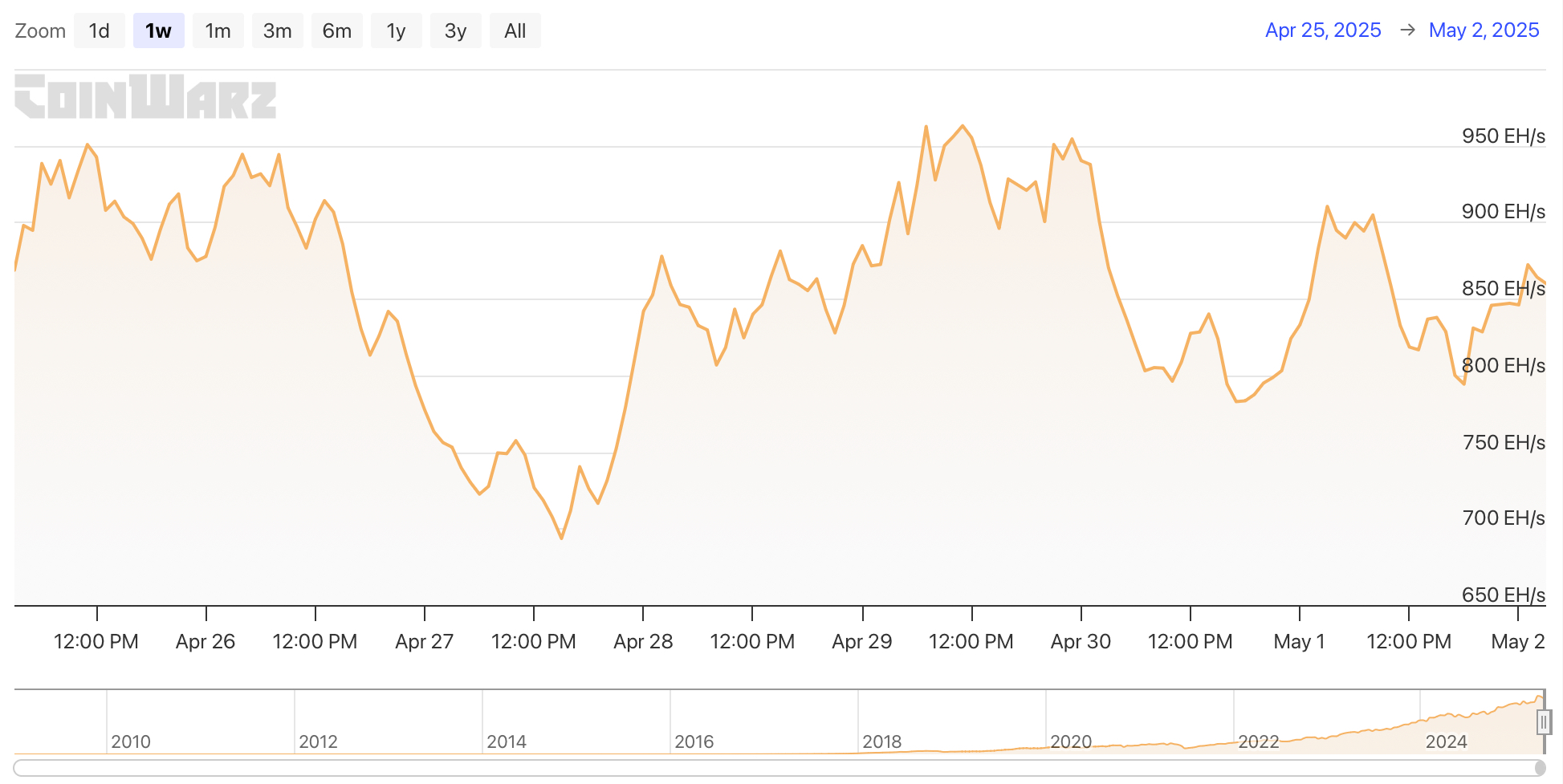
Bitcoin network hash rate data
4. Mining income
According to YCharts data, the total daily income of Bitcoin miners this week (including block rewards and transaction fees) is as follows: April 26: $39.72 million; April 27: $40.23 million; April 28: $42.21 million; April 29: $43.90 million; April 30: $39.64 million. From the trend point of view, the average daily income of miners this week remained between $39 million and $44 million, which was relatively stable overall.
From the perspective of unit computing power income, the current Bitcoin "hash price" is about $50.14 per PH/s, which has rebounded to a relatively high level in the past month. This reflects that under the combined effect of the Bitcoin price rebound and the slowdown in computing power growth, the marginal income of miners per unit computing power has improved.
According to statistics from The Block, the total revenue of Bitcoin miners in April 2025 is about $1.15 billion, down slightly from $1.22 billion in March and $1.24 billion in February. The main reason for the decline is that the price of Bitcoin remained sluggish before April 20, and trading activity was insufficient, which put pressure on miners' income for most of the time. It was not until the price rebounded above $90,000 in late May that income recovered. If the Bitcoin market can continue its upward trend in May and successfully break through in large volume, the monthly income of miners is expected to rebound in stages, thereby improving the current operating environment.
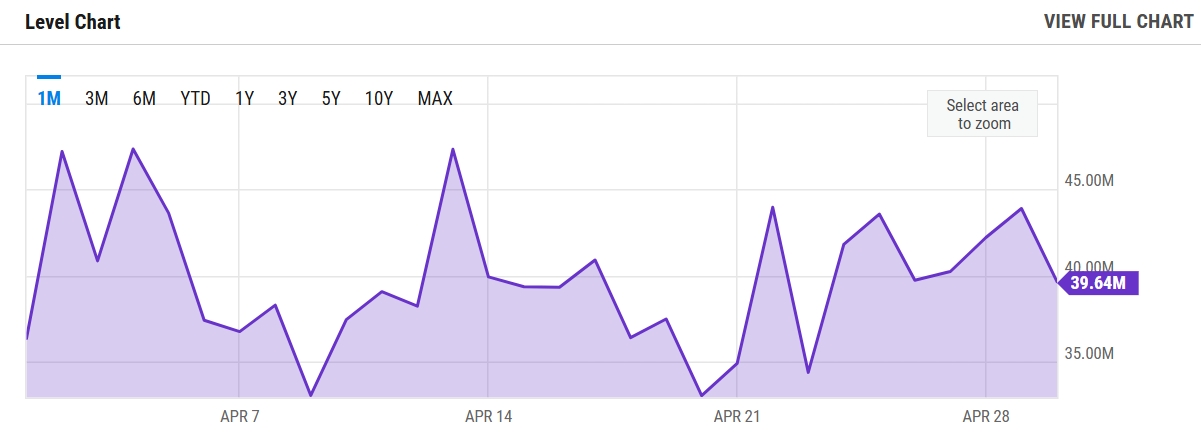
Bitcoin miners daily income data
5. Energy costs and mining efficiency
According to CloverPool data, as of May 2, 2025, the total network hashrate of Bitcoin is 849.98 EH/s, and the current network mining difficulty is 123.23 T. The next round of difficulty adjustment is expected to take place on May 4, with an estimated decrease of 5.31%, and the difficulty will drop to 116.69 T. This trend shows that, against the backdrop of short-term stabilization of Bitcoin prices, some mining machines with poor energy efficiency and high operating costs are gradually withdrawing from the market, resulting in a slowdown in the growth of the total network hashrate or even a slight retracement. The reduction in difficulty will alleviate the mining pressure of the remaining miners to a certain extent, thereby improving the profitability of miners in the short term.
According to MacroMicro's latest model, as of April 30, 2025, the unit production cost of Bitcoin is approximately $90,809.30, and the spot price on that day is $94,207.31, corresponding to a mining cost-to-price ratio of 0.96. This ratio is slightly lower than 1, which means that most miners are still in a slightly profitable range, and the industry's overall profit is in a mild recovery stage. If the price of Bitcoin rises further, the profit space of miners will expand accordingly, and the profitability of the industry is expected to continue to improve, thereby attracting more efficient computing power to enter the market, pushing computing power and difficulty up again.
To sum up, the slowdown in the growth rate of the total network computing power and the expected downward adjustment in the difficulty of mining together constitute the operating logic of Bitcoin mining at the current stage: short-term profit recovery has begun to appear, but whether it can maintain a healthy state in the long run still depends on the Bitcoin price trend and the update progress of high-efficiency equipment.

Bitcoin mining difficulty data
6. Policy and regulatory news
The President of the Swiss National Bank once again rejected the call to increase Bitcoin holdings, saying it "does not meet the high standards of reserve currencies"
On April 26, Martin Schlegel, president of the Swiss National Bank, said on Friday: "The market liquidity of cryptocurrencies in times of crisis will be questioned, and their high volatility is also a major risk to long-term value preservation. In short, it can be said that cryptocurrencies have not yet met our high requirements for reserve currencies." He made the above statement in response to the Bitcoin Initiative, an advocacy organization,'s suggestion to increase holdings of Bitcoin. The organization's research shows that if 1% of the investment was allocated to Bitcoin in 2015, the Swiss National Bank's overall return would have almost doubled, with only a slight increase in volatility.
El Salvador’s Bitcoin Strategy Moves Forward, Bypassing IMF Restrictions
In order to obtain a $1.4 billion loan from the International Monetary Fund (IMF), the Salvadoran government previously promised that the financial sector would no longer increase its holdings of Bitcoin and announced that Bitcoin would be removed as a means of compulsory payment and taxation from May 1. However, on April 28, the Salvadoran Bitcoin Office posted on the X platform that it would "continue to add one Bitcoin to the strategic reserve every day." As of April 30, the office had added 32 Bitcoins in April, with a total holding of more than 6,160 Bitcoins, with a market value of approximately $584 million. Analysis pointed out that El Salvador is using this office to technically circumvent the restrictions set by the IMF on the "financial sector" and continue to advance the national Bitcoin strategy led by President Bukele.
Arizona House passes Bitcoin Reserve bill, moving forward with establishing cryptocurrency reserve
On April 29, the Arizona House of Representatives passed two bills that could allow the state to adopt Bitcoin or other cryptocurrencies to establish reserves. In the third reading of Senate Bill 1025 (SB 1025) on April 28, 31 members voted in favor and 25 members opposed. Another similar bill, SB 1373, passed with 37 votes in favor and 19 votes against. These approvals bring these bills closer to being signed into law than similar initiatives in any other state in the United States. Meanwhile, President Trump signed an executive order in March proposing the establishment of a "strategic Bitcoin reserve" and a "digital asset reserve."
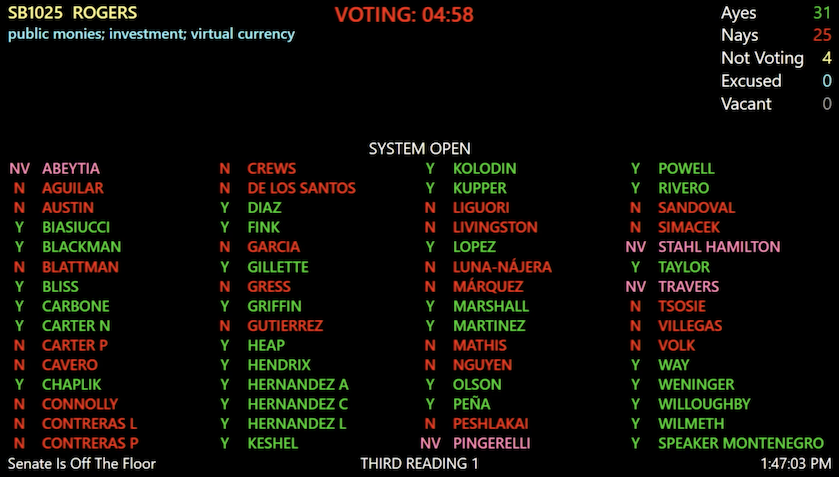
Related images
Nigerian Government Passes Law Recognizing Bitcoin as a Security
On May 1, Nigerian President Tinubu signed the Investment and Securities Act 2025 last month, officially classifying Bitcoin and other digital assets as securities. This marks the first time that Nigerian regulators have officially recognized the legal status of Bitcoin.
The new bill will give the Nigerian Securities and Exchange Commission (SEC) the power to regulate virtual asset service providers (VASPs), digital asset operators (DAOPs) and digital asset exchanges (DAEs). The bill also cracks down on Ponzi schemes, and violators will face a fine of at least 20 million naira (about $12,430) and up to 10 years in prison.
7. Mining News
U.S. Secretary of Commerce: The United States will vigorously promote the development of Bitcoin mining in the country
On April 29, according to Bitcoin Magazine, U.S. Secretary of Commerce Howard Lutnick said that the United States will "make every effort to promote the development of the Bitcoin mining industry in the country."

Related images
Cambridge University study: Bitcoin mining is turning to sustainable energy
On April 29, the latest research report of the Cambridge University Center for Finance (CCAF) showed that the sustainable energy utilization rate of the Bitcoin mining industry has risen to 52.4%, a significant increase from 37.6% in 2022. The report pointed out that natural gas (38.2%) has replaced coal (8.9%) as the largest single energy source, and the utilization rate of coal has dropped sharply from 36.6% in 2022. The data also showed that North America dominates global mining activities, with the United States accounting for 75.4% and Canada accounting for 7.1%. The study is based on a survey of 49 mining companies in 23 countries, covering 48% of global mining activities, and estimates that Bitcoin consumes 138 terawatt hours of electricity per year, accounting for about 0.5% of global electricity consumption.
8. Bitcoin related news
Bitcoin holdings of global companies and countries (statistics for this week)
1. El Salvador continues to accumulate Bitcoin, with holdings reaching 6,159 coins . According to an announcement by the El Salvador Bitcoin Office on April 27, the country’s national strategic reserve added 1 Bitcoin, bringing total holdings to 6,159.18 coins, and continues to implement the “one bitcoin per day” increase plan.
2. Strategy increased its holdings of 15,355 bitcoins in one week, and its total holdings exceeded 550,000 . According to news on April 28, Strategy purchased 15,355 BTC at a price of about $92,737 per unit for about $1.42 billion between April 21 and 27. As of April 28, the cumulative holdings reached 553,555 BTC, with a total investment of about $37.9 billion.
3. Japan's ANAP purchased another 35 bitcoins, and its holdings exceeded 50 bitcoins
On April 30, Japanese fashion brand ANAP announced the purchase of an additional 35 bitcoins. The company's total holdings are currently 51.6579 bitcoins, and it continues to advance its bitcoin asset allocation strategy.
4. Australia’s Monochrome Bitcoin ETF’s holdings increased to 345
As of April 29, Monochrome Spot Bitcoin ETF (IBTC) held 345 BTC with a market value of approximately US$50.9612 million, indicating that investors continue to be optimistic about Bitcoin assets.
5. BlackRock increased its holdings by more than 25,000 bitcoins in a week, with a total holding of more than 600,000 bitcoins <br>According to Lookonchain tracking data, BlackRock's IBIT ETF increased its holdings by 25,430 BTC in the past 7 days, worth about US$2.37 billion. As of April 30, the total holdings reached 601,209 BTC, with a total market value of approximately US$56.11 billion.
CryptoQuant analyst: Demand indicators show dormant funds are flowing back into Bitcoin
On April 26, CryptoQuant analyst ITTech said that apparent demand indicators showed a sharp rebound in Bitcoin buying interest. The strong rebound from the extreme negative value (less than -200,000 Bitcoins) indicated that previously dormant funds were flowing back in.
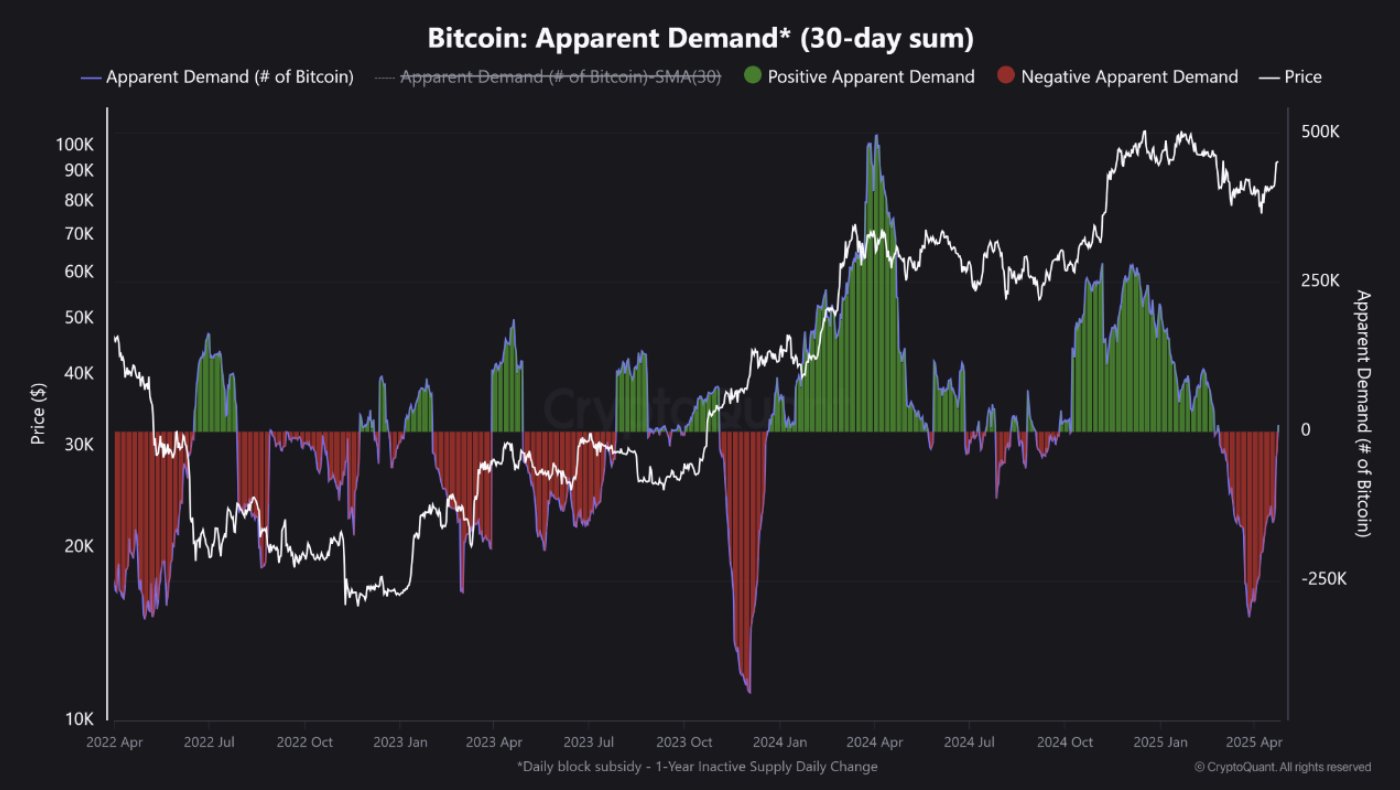
Related images
Bitcoin core developers propose to abolish the "satoshi" unit and remove decimal points, sparking community controversy
On April 27, while the Bitcoin community was busy optimizing the user experience, launching custody solutions, lobbying for regulation, and wooing institutions, John Carvalho, a core developer and CEO of Synonym, proposed a simpler solution: abolishing the "satoshi" unit and removing the decimal point to lower the threshold for newcomers to understand. In the BIP proposal in December 2024, he advocated that 100 million "satoshis" split from 1 Bitcoin be directly defined as "Bitcoins". For example, a transaction currently displayed as 0.00010000 BTC will be displayed as 10,000 BTC in the new system, completely reshaping the measurement standard for "Bitcoin millionaires".
This move quickly sparked controversy. Opponents joked with the "pizza theory": if each slice of pizza is called a "full portion", eight portions must be ordered at a time to meet demand, implicitly mocking the absurdity of unit inflation. More community members are worried that if the total amount is "expanded" from 21 million to 21 billion, it will shake the core foundation of the Bitcoin scarcity narrative. However, Carvalho's proposal may be quietly accumulating strength. On April 25, he posted on the X platform: "Although it is still a minority, more and more people are beginning to accept the idea of calling the smallest unit of Bitcoin 'Bitcoin' and removing the decimal point."
CryptoQuant analyst: Demand indicators show dormant funds are flowing back into Bitcoin
On April 27, CryptoQuant analyst ITTech said that apparent demand indicators showed a sharp rebound in Bitcoin buying interest. The strong rebound from the extreme negative value (less than -200,000 Bitcoins) indicated that previously dormant funds were flowing back in.
10x Research: Bitcoin may break through $100,000 after short-term consolidation
On April 28, 10x Research released an analysis report pointing out that although in the short term, the resistance level of $94,000-95,000 will still limit Bitcoin's rise. Two reversal indicators have turned bearish, and the stochastic indicator has risen to 95%, suggesting that there is a short-term downside risk. However, analysts believe that this only represents a short-term consolidation phase before breaking through $100,000.
Standard Chartered Bank: Bitcoin is expected to exceed $120,000 in Q2
According to The Block, Geoffrey Kendrick, head of global digital asset research at Standard Chartered Bank, said in his latest report that Bitcoin is expected to reach a new historical high of about $120,000 in the second quarter of 2025 and maintain its target price of $200,000 by the end of 2025. Kendrick believes that now is the time to buy Bitcoin, and multiple indicators support price increases, including the trend of US investors seeking non-US assets, the continued accumulation of "whale" investors, and the safe haven transfer of ETF funds from gold to Bitcoin. He emphasized that Bitcoin, due to its decentralized nature, is more effective than gold in hedging the risks of the existing financial system.
Presto Research Director: Bitcoin is expected to rise to $210,000 by the end of 2025
On April 28, according to Cointelegraph, Peter Chung, head of research at quantitative trading company Presto, reiterated his prediction that Bitcoin will rise to $210,000 by the end of 2025.
Chung said that the expansion of global liquidity is the main driving force behind his long-term bullish view on Bitcoin. Chung also admitted that this year's market environment is not as ideal as expected, especially the challenges of the macroeconomic situation and the market's response.
However, he described the recent market correction as a healthy adjustment, believing that it laid a more solid foundation for Bitcoin to move towards mainstream financial assets. He said: Looking back, I think this is actually a healthy correction that paves the way for Bitcoin to be further repriced as a mainstream asset.
Bernstein: With the wave of corporate holdings and the return of ETF funds, it is expected to push Bitcoin prices to new highs
According to news on April 29, this year's Bitcoin price narrative fluctuates between the correlation of "gold" and "Nasdaq", but Bernstein analysts believe that short-term correlation is highly misleading. The exhaustion of retail selling, the tide of corporate holdings and the return of ETF funds are the key indicators, which may drive "supply tightening" to new highs. Last week, Twenty One Capital announced an initial hoard of 42,000 BTC (about US$4 billion) and joined the competition of companies such as Strategy. Currently, about 80 companies hold a total of 700,000 BTC, accounting for 3.4% of the total supply. The US spot Bitcoin ETF had a net inflow of US$3 billion last week, a five-month high, and its total holdings accounted for 5.5% of the circulation of Bitcoin. The proportion of institutions increased from 20% in September last year to 33%, of which 48% were held by investment advisors, reflecting the demand for asset allocation. Combined with corporate holdings, institutional capital has controlled 9% of the BTC supply. If the US government implements strategic reserves, it may trigger a competition among sovereign states to hoard coins. The proportion of BTC balances on exchanges has dropped from 16% at the end of 2023 to 13%, but some assets have only been transferred to ETF custodians.
Bernstein analysts estimate that Bitcoin will reach a cycle peak of around $200,000 by the end of 2025, $500,000 by the end of 2029, and $1 million by the end of 2033, with intermittent one-year bear markets in between.
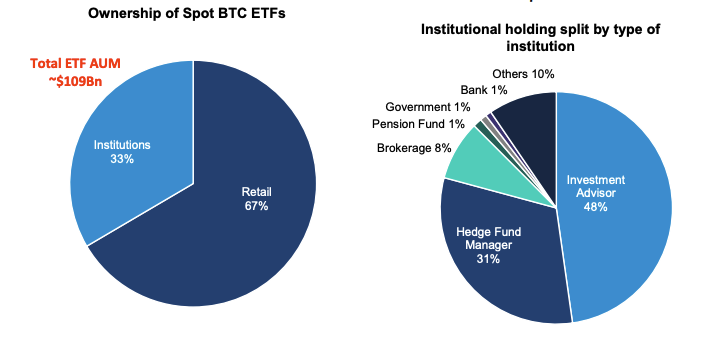
Related images
Executive Director of Trump Crypto Commission: Countries are engaged in a "space race"-style Bitcoin hoarding, and the United States regards Bitcoin as digital gold
On April 30, Bo Hines, executive director of the Trump Crypto Committee, said that countries are engaged in a Bitcoin hoarding competition similar to the "space race." We regard Bitcoin as digital gold.
CZ: Many countries consult on establishing cryptocurrency reserves, Bitcoin ETF leads the current cycle
On April 30, according to Eric Balchunas' tweet, Changpeng Zhao (CZ) recently said that he is providing advice to several countries outside Europe, guiding them on how to build cryptocurrency reserves like the United States. He pointed out that Europe is not currently within the scope of this discussion. CZ explained why he invested in the X platform, emphasizing that "free currency" needs to be based on "free speech." Regarding the current market, he believes that ETFs are the main driving force of this cycle, led by Bitcoin. Although Ethereum's performance is not as prominent as Bitcoin, he expects Bitcoin's success to eventually drive other cryptocurrencies, and emphasized that "we are still in the early stages."



